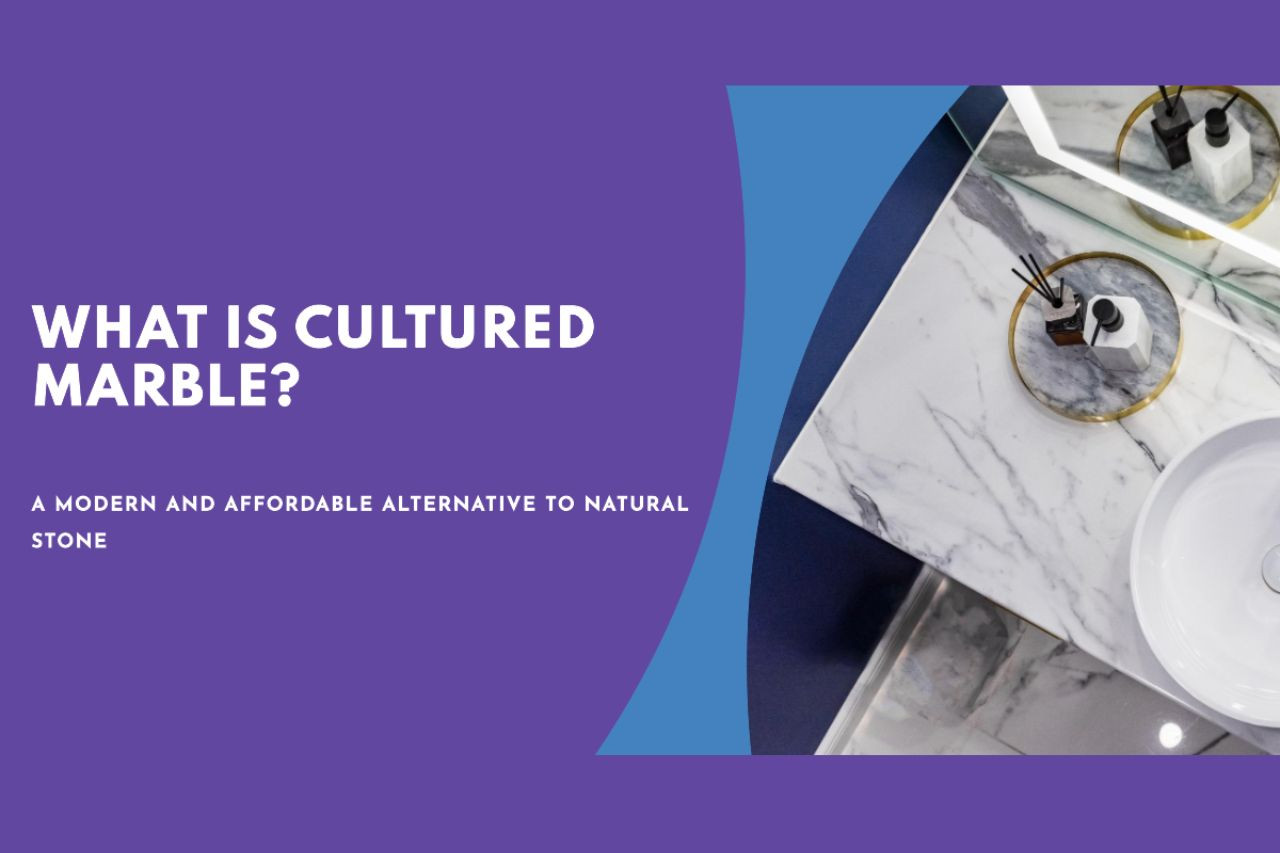18th Sep 2023
In a world dominated by the quest for the elegant, the durable, and the affordable, few materials have captured homeowners' imaginations as cultured marble has. If you’ve ever marveled at a bathroom vanity top or shower wall that seems to combine the best of marble's beauty with improved resilience, chances are you've encountered cultured marble.
But what exactly is cultured marble? How is it made? And why has it become a favorite choice for many homeowners and interior designers? Let's unravel the mystery behind this beautiful and versatile material.
Basics: Defining Cultured Marble
Cultured marble is not a naturally occurring stone, unlike its namesake. Instead, it’s a blend of crushed natural marble, polyester resins, and pigments. The mixture produces a surface that captures the elegance of genuine marble, but with added benefits.
How Cultured Marble Comes To Life?

- Mixing: The process starts with crushed natural marble chess set. This marble powder, typically 75% of the mixture, is combined with liquid polyester resin, which acts as a binder. To this blend, pigments are added to achieve the desired color and patterns that closely mimic natural stone.
- Pouring and Molding: Once mixed, the slurry is poured into open molds, usually made from rubber or metal. These molds can be shaped to produce bathtubs, sinks, countertops, and more.
- Setting: The poured mixture then needs time to harden. To speed up this process, a catalyst is added to the mix before pouring. Once set, the result is a solid, durable material.
- Finishing: The hardened product is then removed from the molds and polished to achieve the desired sheen. The finishing process can also involve adding a clear or gel coat, which provides a protective layer to the cultured marble product, enhancing its durability and water resistance.
Benefits of Cultured Marble
- Aesthetic Flexibility: The range of colors, shades, and veining options is virtually limitless. This means homeowners can achieve the exact look they desire, whether that's a mimicry of high-end Carrara marble onyx lamp or a unique, custom shade.
- Durability: Cultured marble is resistant to chipping, cracking, and staining, making it perfect for high-traffic areas like bathrooms.
- Easy Maintenance: Unlike natural marble, cultured marble doesn’t require regular sealing. Its non-porous nature means it's resistant to mold and mildew. Simple cleaning with non-abrasive agents keeps it looking pristine.
- Cost-Effective: Compared to natural marble, cultured marble is more affordable. This cost-effectiveness is a boon for homeowners who want the marble look without the marble price.
- Seamless Design: Items like vanity tops can be made with integrated sinks, ensuring a seamless look and eliminating crevices where dirt can accumulate.
Common Applications
Cultured marble's versatility means it's used in a myriad of home applications:
1. Bathroom Vanity Tops:

Arguably the crown jewel of cultured marble applications, bathroom vanity tops are where this material truly shines. The bathroom, a place of daily rituals and self-care, deserves a surface that’s both beautiful and functional. Cultured marble vanity tops not only provide a luxurious feel but also come with practical benefits.
Many of these tops are designed with integrated sinks. This seamless design eliminates the need for sink cutouts and ensures a smooth transition from the countertop to the sink basin, reducing the nooks and crannies where dirt and grime could accumulate. Additionally, this integration means fewer leaks and maintenance issues in the long run.
2. Shower Walls and Pans:

The bathroom experience is incomplete without a refreshing shower, and cultured marble makes this experience even more luxurious. The material's water-resistant nature, combined with its aesthetic appeal, makes it a top choice for shower walls and pans.
Traditional tiled showers can have problems with grout lines becoming dirty or even moldy over time. In contrast, cultured marble shower walls are often designed as large, single panels, eliminating grout lines and providing a sleek, modern appearance. The smooth surface is not only easy to clean but also creates a visually expansive feel, making the bathroom appear larger and more open.
3. Bathtubs:

Imagine sinking into a bathtub after a long day – the very thought is relaxing. Now, imagine that bathtub made of marble, exuding warmth and luxury. Cultured marble bathtubs are a testament to the material's adaptability and elegance.
They offer homeowners a seamless design, devoid of the joints that can be found in other tub materials. This seamless nature not only adds to the aesthetic appeal but also ensures that the tub is easier to clean and maintain. The inherent water resistance of cultured marble further ensures a long lifespan for the tub, making it a wise investment for homeowners.
4. Backsplashes:

The beauty of cultured marble doesn’t stop at bathtubs and showers. It extends to other areas of the bathroom and even the kitchen in the form of backsplashes. These protective panels, often found behind sinks or cooktops, prevent splashes of water or food from staining walls.
When made from cultured marble, backsplashes not only serve a functional purpose but also elevate the design of the space. They can be matched to vanity tops or countertops, ensuring a harmonious, cohesive design throughout the room. The easy-to-clean nature of cultured marble also means that any spills or splatters can be wiped away in a jiffy, keeping the space looking pristine.
Potential Drawbacks
While cultured marble boasts many benefits, it's essential to note potential drawbacks:
- Heat Sensitivity: Prolonged exposure to high temperatures can damage the surface.
- Scratching: While resistant to many damages, it's softer than granite, making it susceptible to scratches.
Caring For Cultured Marble
To maintain its beauty:
1. Avoid Abrasive Cleaners:
The surface of cultured marble, while robust in many aspects, can be sensitive to aggressive cleaning agents. Abrasive cleaners, which may include scouring powders or pads, can leave unsightly scratches on the surface. These scratches not only mar the beauty of the installation but can also become areas where dirt and bacteria accumulate over time.
Instead of reaching for those harsh scrubbing agents, opt for a soft cloth or a sponge. When combined with a mild detergent, this duo will effectively clean the surface without compromising its integrity.
2. Use Mild Detergents:
A common misconception is that stronger cleaning agents equate to a cleaner surface. In the case of cultured marble, this couldn’t be further from the truth. Strong, acidic, or alkaline cleaning agents can strip away the protective gel coat on cultured marble, making it more susceptible to stains and scratches.
For daily cleaning, a simple solution of water and a few drops of mild dish soap works wonders. This gentle combination effectively lifts dirt and grime without harming the surface. For stubborn stains or soap scum, always opt for a cultured marble-approved cleaner available in most home improvement stores.
3. Avoid Prolonged Heat:
While cultured marble is a resilient material, it is not entirely immune to the effects of extreme heat. Prolonged exposure to hot objects, such as curling irons or hot pots, can lead to discoloration or even burn marks on the surface.
To prevent such damage, always use protective barriers between the cultured marble surface and hot objects. Mats, trivets, or even thick towels can act as buffers, ensuring that the heat does not come in direct contact with the marble surface. Being proactive in this manner can save you from costly repairs or replacements in the future.
Also check my guide on how to clean onyx marble sink
In Conclusion
Cultured marble elegantly bridges the gap between luxury and practicality. Whether you're renovating a bathroom or looking for a durable countertop option, it offers the beauty of marble without its vulnerabilities. As with any material, understanding its strengths and weaknesses is key to ensuring it meets your needs and remains a centerpiece in your home for years to come.





